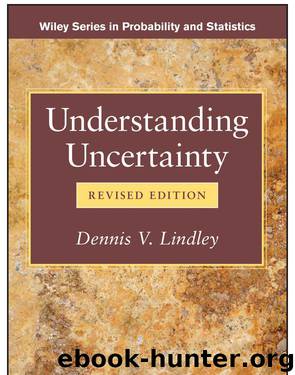Understanding Uncertainty by Lindley Dennis V

Author:Lindley, Dennis V.
Language: eng
Format: epub
Publisher: Wiley
Published: 2013-11-26T05:00:00+00:00
Chapter 9
Variation
9.1 Variation and Uncertainty
Variation often gives rise to uncertainty. Though we can recognize a group of objects called teapots, the variation present from one teapot to another results in our being uncertain whether we shall spill some of the tea when first pouring from a strange pot, for some pots are good pourers, some are not. More seriously, all biological material exhibits variation; even the simple influenza virus varies, with the consequence that we are uncertain what vaccine to use against it. Human beings show variation that we rightly cherish, yet it gives rise to uncertainty, whether in what size of trousers a retailer should stock, or in a stranger's reaction to a request.
There are only a few topics where variation is not present. Precision engineering is capable of making objects, like the balls in the urn, that are, for practical purposes, indistinguishable and portray no obvious variation. One atom of an isotope of hydrogen is regarded as the same as any other atom and the behavior of the isotope in the presence of oxygen can be predicted perfectly. We can say, in the spirit of §7.3, that one atom can be exchanged for another. Physics and chemistry are both founded on this lack of variation that partly explains why physical scientists were so uncomfortable with quantum physics and its unpredictability. It also helps to explain why those two subjects have advanced more than others, like biology, because they are not hampered by variation and so have less uncertainty. Biology is now advancing more quickly since some aspects of it have been reduced to the chemistry of amino acids. However, the laws of genetics contain randomness and the resulting variation is basic to the concept of evolution, where variants more suited to their environment stand a better chance of producing offspring that survive and breed.
Variation produces uncertainty because you cannot be sure what the variable material will do. Uncertainty inevitably necessitates description in terms of probability, hence probability is an essential tool in the handling of variation. This chapter is devoted to a study of variation and probability, beginning with a simple example, the familiar balls in an urn. Before doing so, we need to look at the rule of the extension of the conversation again because it plays a key role in the analysis and provides another form of Bayes rule. In equation (5.7) of §5.6, the rule was presented as extending from one event E to include another event F, with its complement F c; and in §8.1 it was mentioned that, just as the basic rules applied to any number of events, not just two, so would the extension rule. It is the precise form of this that needs to be discussed. Consider events , which are exclusive (§5.2) in that at most one of them can be true, and also exhaustive, in that one of them must be true, or they exhaust the possibilities; they are said to form a partition of the events. Clearly the original pair, F and F c, form a partition.
Download
This site does not store any files on its server. We only index and link to content provided by other sites. Please contact the content providers to delete copyright contents if any and email us, we'll remove relevant links or contents immediately.
Modelling of Convective Heat and Mass Transfer in Rotating Flows by Igor V. Shevchuk(6406)
Weapons of Math Destruction by Cathy O'Neil(6202)
Factfulness: Ten Reasons We're Wrong About the World – and Why Things Are Better Than You Think by Hans Rosling(4710)
Descartes' Error by Antonio Damasio(3247)
A Mind For Numbers: How to Excel at Math and Science (Even If You Flunked Algebra) by Barbara Oakley(3247)
Factfulness_Ten Reasons We're Wrong About the World_and Why Things Are Better Than You Think by Hans Rosling(3216)
TCP IP by Todd Lammle(3153)
Fooled by Randomness: The Hidden Role of Chance in Life and in the Markets by Nassim Nicholas Taleb(3076)
Applied Predictive Modeling by Max Kuhn & Kjell Johnson(3038)
The Tyranny of Metrics by Jerry Z. Muller(3022)
The Book of Numbers by Peter Bentley(2926)
The Great Unknown by Marcus du Sautoy(2659)
Once Upon an Algorithm by Martin Erwig(2616)
Easy Algebra Step-by-Step by Sandra Luna McCune(2599)
Lady Luck by Kristen Ashley(2550)
Police Exams Prep 2018-2019 by Kaplan Test Prep(2513)
Practical Guide To Principal Component Methods in R (Multivariate Analysis Book 2) by Alboukadel Kassambara(2510)
All Things Reconsidered by Bill Thompson III(2369)
Linear Time-Invariant Systems, Behaviors and Modules by Ulrich Oberst & Martin Scheicher & Ingrid Scheicher(2345)
